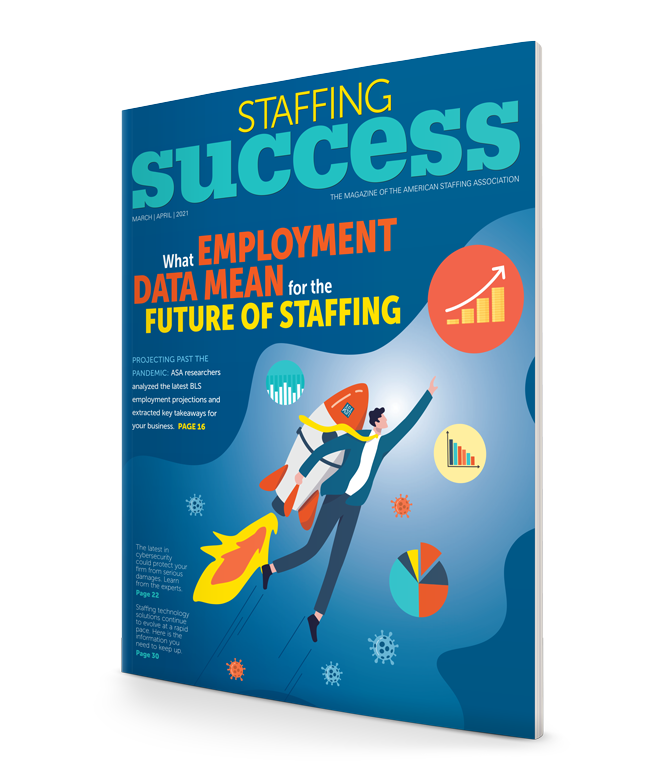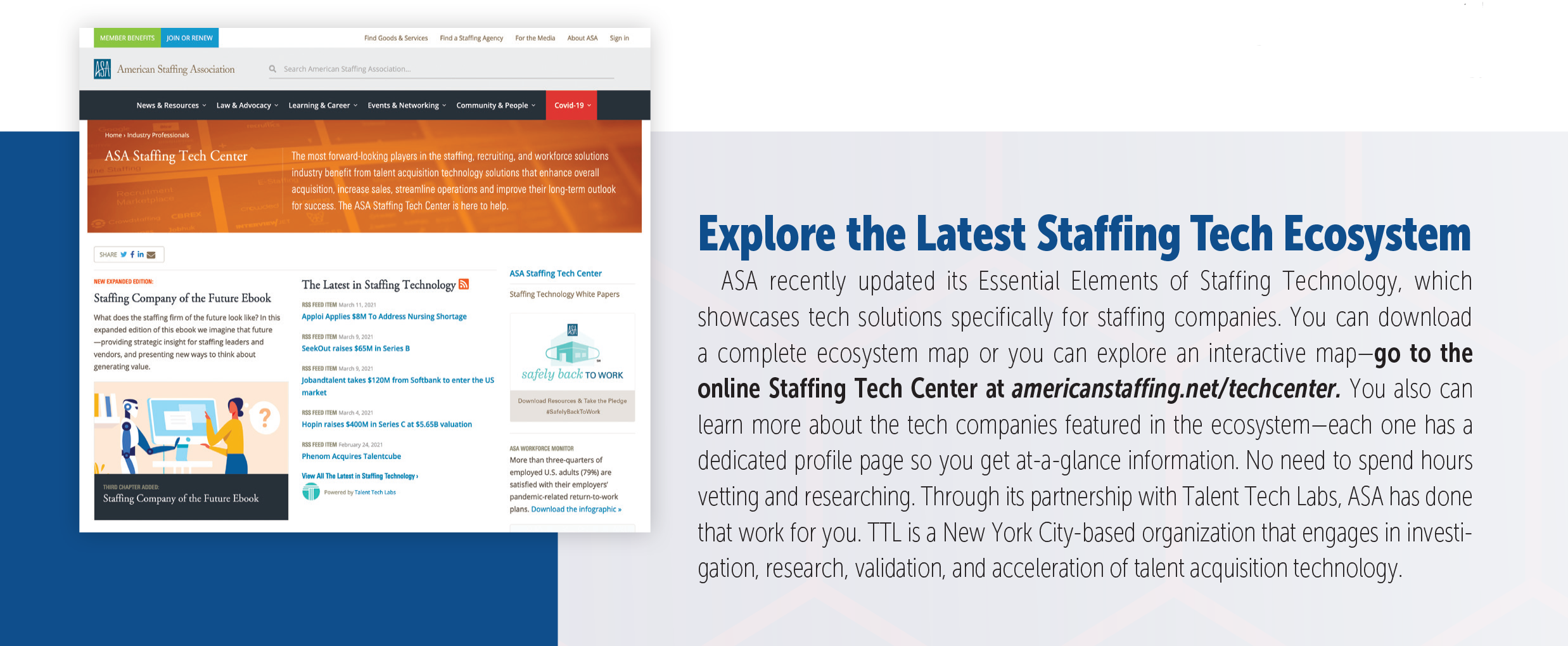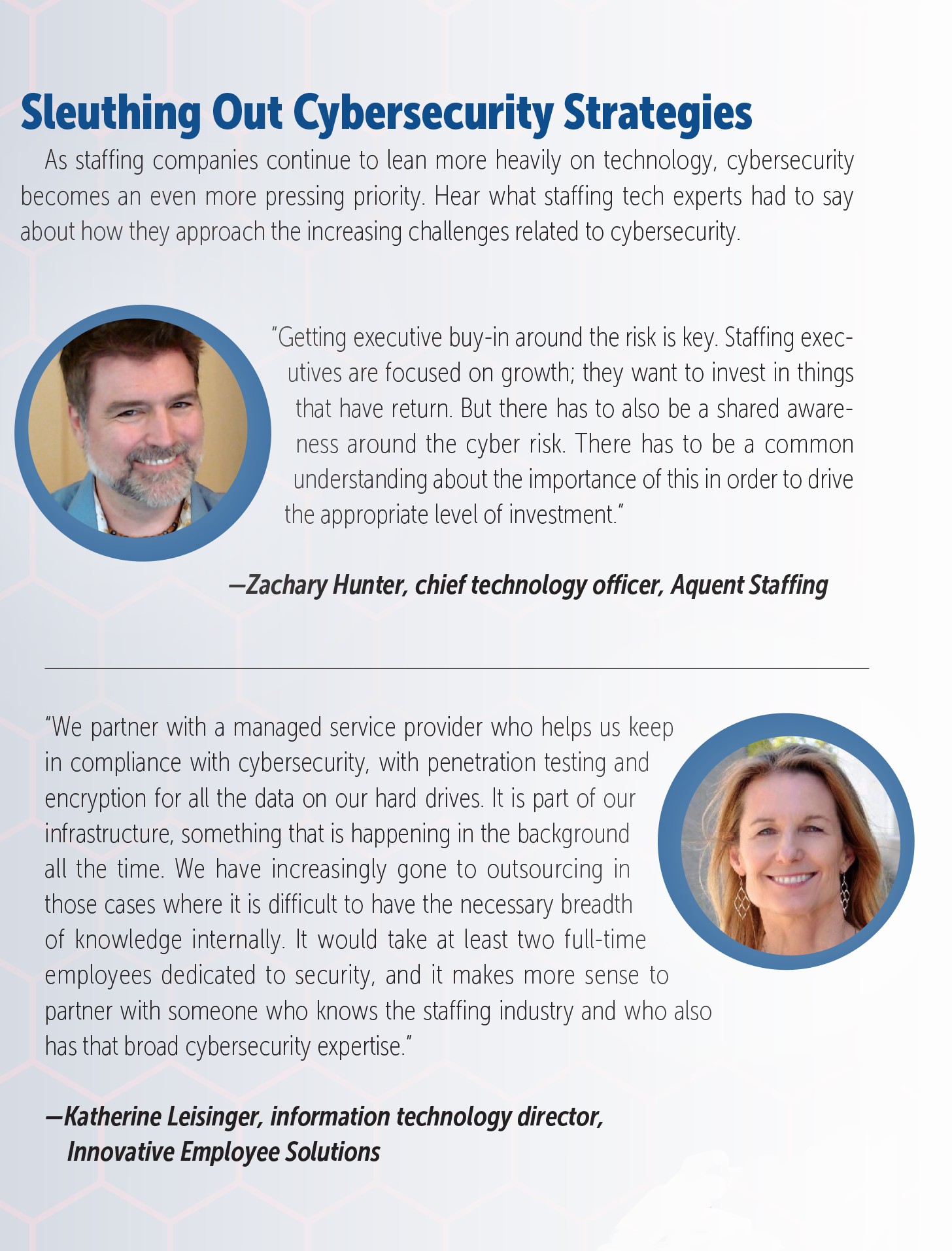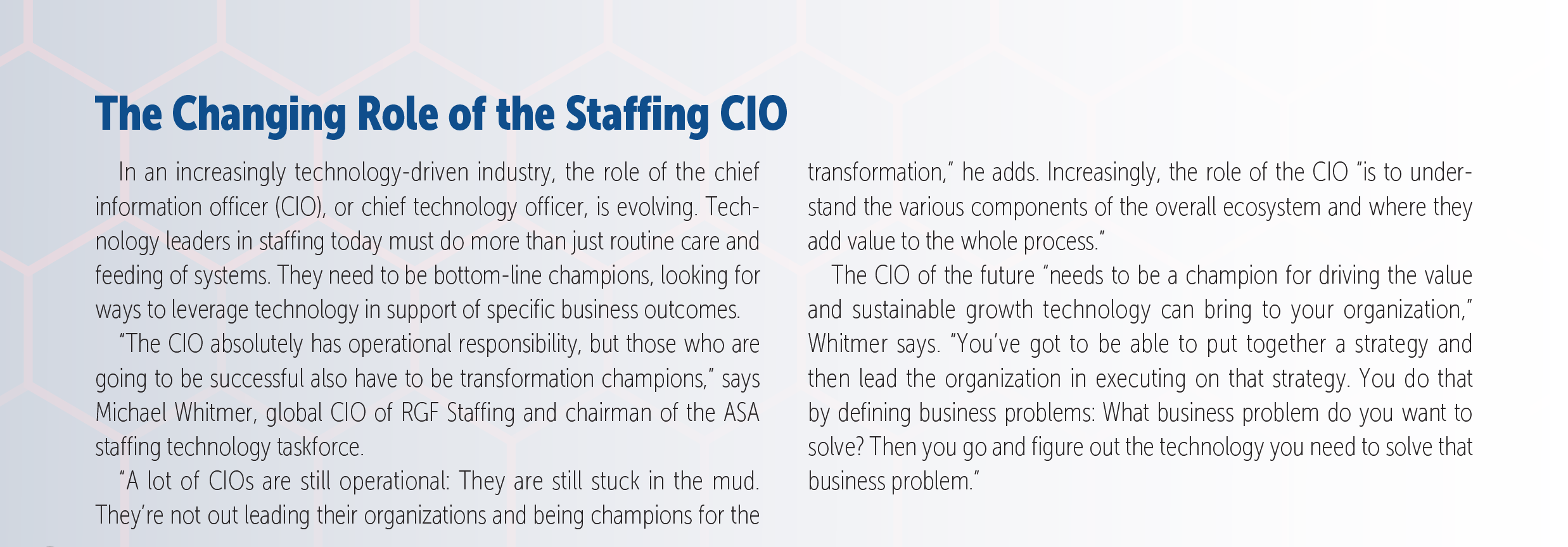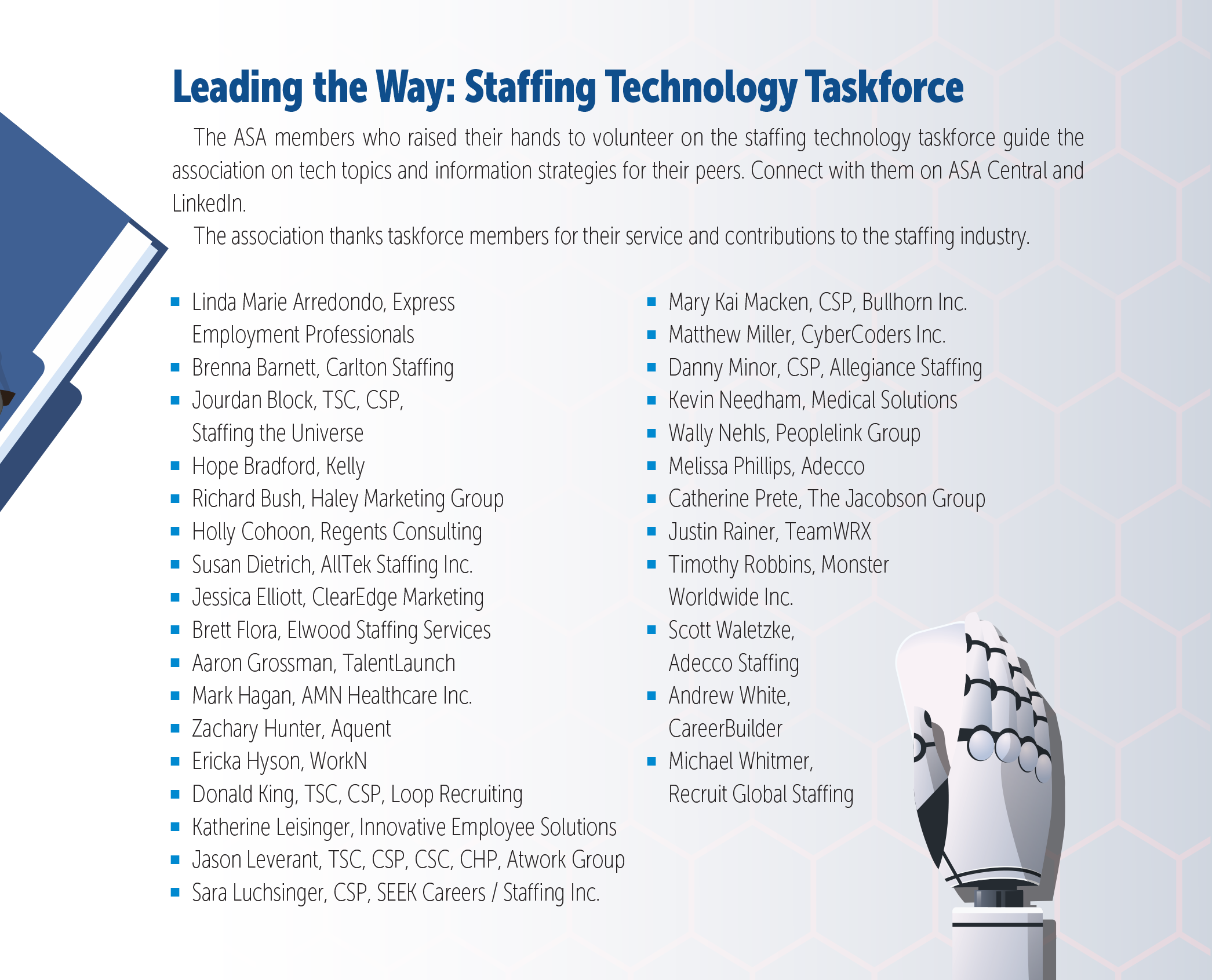The Essential Elements of Staffing Technology—it’s a long name for a simple solution. This resource, designed specifically for staffing and recruiting firms, is a color-coded graphic that maps out an ecosystem of tech solutions companies. Each year, ASA partners with New York City-based Talent Tech Labs to provide an updated ecosystem of companies, so that staffing firms can quickly access reliable information. What’s more, this information—featuring the companies and the solutions they provide—is organized into the different aspects of staffing business operations, such as job advertising, candidate engagement, social search, applicant tracking, etc.
This year, given the effects of the pandemic on the U.S. economy and business operations overall, updates to the Essential Elements of Staffing Technology take on even more importance. Staffing Success reached out to the industry’s top minds in staffing tech solutions—members of the ASA staffing technology taskforce—for context. Specifically, how do updates to the ecosystem and developing tech trends relate to the current state of the staffing industry? How do the updates support those trends? And how can staffing companies stay ahead of technology advancements that could disrupt their operations?
“These new tools will allow both small and larger companies to be highly productive,” says Michael Whitmer, global chief information officer of RGF Staffing, headquartered in the Netherlands with operations throughout the U.S. Whitmer is chair of the ASA staffing technology taskforce, which is comprised of member volunteers—all of whom specialize in tech-related issues for their staffing companies.
Technology Trends
As Whitmer explains it: The ecosystem updates convene emerging technologies that can help staffing firms be simultaneously more efficient and more personalized in their efforts. The updates address a number of evolutions on the tech landscape, including a renewed focus on the hiring stage and tech tools that support effective candidate engagement.
“We’ve begun listing staffing-on-demand platforms,” Whitmer explains. “These are mostly mobile-first applications that allow for the entire staffing process to be digitized and automated, end-to-end, all through the mobile device.”
Using these platforms, workers can apply and get hired, fulfill their assignments, submit their time, and manage their paychecks. “They can get learning, they can show their availability—all those ways in which they interact with a staffing company can be done through an app,” Whitmer adds.
Additionally, the ecosystem now includes robotic process automation (RPA) tools. “These are tools that allow you to fully automate those processes that require some intelligence, but are also repetitive,” Whitmer notes. “A lot of that goes into your back office—payroll, billing, financials. RPA lets you automate those functions while eliminating a lot of paper, a lot of manual work, a lot of errors and dual entry.”
The updated ecosystem also introduces voice and chat tools driven by conversational artificial intelligence. Such tools can engage candidates and workers in human-language ways and handle frequently asked questions with great efficiency.
All of these enhancements to the ecosystem reflect a steady increase in the importance of technology solutions and strategies across the staffing industry.
“Technology is a core part of our business. It has been one of our key differentiators,” says Matt Miller, chief technology officer for Irvine, CA-based CyberCoders and taskforce member. “Technology helps us to find the right talent. It supports business development, and it helps us keep people engaged with our brand.”
Miller says that, overall, the ecosystem helps him stay abreast of the latest tech trends. “The marketplace is always growing and it’s hard to know where to even start. The ecosystem helps us to vet the technologies and to make best use of our time as we are doing that,” he explains.
For Katherine Leisinger, information technology director at San Diego-based Innovative Employee Solutions, technology is key to staying current in a fluid regulatory environment. “We constantly need to respond to new legislation and new business requirements, and technology is what makes that possible,” says Leisinger, also a taskforce member.
California, for instance, recently started requiring sexual harassment prevention training for all workers. “To deploy something like that to our entire workforce, we have to rely on technology to distribute that training.”
The ASA ecosystem “has been a great tool for us, in terms of giving us an overview of who is in the technology space and which companies we should be partnering with,” she notes. “It’s been very helpful.”
To better understand how technology in general—and the ASA ecosystem in particular—can support staffing success, it’s helpful to look at how staffing firms have leveraged technology in the context of these key industry trends and initiatives: diversity, return to work, resiliency, talent pipeline, and data utilization.
Diversity
The conversation about diversity has shifted to include deeper issues of equity, social justice, and history. Technology helps the staffing industry to take on a new posture regarding issues of race and bias.
Whitmer points to AI as a key enabler here. “We leverage AI for sourcing, which is matching individuals to job opportunities,” he explains. “These AI tools work beyond just doing keyword matches. They can use contextual and historical data, so it’s a richer, better match. You get a more diverse pool of potential candidates: If they’re out there in any way, shape, or form, and they’re qualified to do that role, the AI will include them.”
Zachary Hunter, chief technology officer for Boston-based Aquent and taskforce member, says his team is in the early stages of a strategic initiative to ensure clients are receiving a diverse slate of candidates. He is leveraging anonymized data to evaluate the overall diversity of a given group of candidates, so that clients are always being given a well-rounded slate of applicants.
Leisinger takes a similar, data-driven approach. “For our clients, we have robust reporting capabilities in support of their diversity efforts, and for our internal staff we partner with a technology provider who has a built-in solution to analyze pay equity,” she explains. “That helps us evaluate whether our compensation needs to be adjusted to reflect a more equitable payment system.”
Return to Work
As the nation looks to open back up postpandemic, the staffing industry can play a pivotal role in supporting a safe return to work. Staffing firms can leverage technology to help ensure a safe workplace and to support their clients’ efforts to reopen with worker safety foremost in mind.
“We can be leveraging technology from a safety perspective, in terms of geotracking of individuals, which could lead into contact tracing,” Whitmer says. “We can support our customers’ efforts to be checking temperatures or validating that people have properly quarantined. You need technology to track and manage that.”
In the immediate term, Miller’s firm has leaned heavily on IT to support workers at home. “We are replacing our recruiters’ computers with laptops so they can be more mobile. We also replaced our on-premises phone system with a cloud-based system, to support our remote work infrastructure. It allows us to measure our recruiters’ effectiveness and to see how they are spending their time,” he notes.
At Aquent, “it’s about highlighting the fading importance of geographic proximity,” Hunter explains. He’s looking for IT solutions that help to support a workforce no longer tied to place, as well as tools that can accommodate changing work patterns.
“There are new flavors of remote work, with people working remote four days a week and coming in one day a week, or jobs that start remote and then come back into the office,” he says. “The technology helps us to classify all those different scenarios so we can effectively match people’s schedules and availability with those specific client needs.”
Resiliency
Resiliency is the power to stand firm regardless of which way the wind is blowing. Technology helps support that in an everchanging legal and regulatory landscape.
“California, for example, implemented in 2019 a new paycheck requirement where the state mandated paid Covid leave, and you had to show the accrual of that on the paycheck,” Leisinger explains. “They literally gave us a week to implement a new form of leave tracking. It was a herculean task, but we were able to turn to our technology partners who worked with our IT teams, along with the HR and payroll departments. They all worked together to get that on the paychecks within a week.”
For Miller, a robust applicant tracking system helped drive resiliency during Covid-related shutdowns.
“We have a database of some 25 million people, and the system leverages matching algorithms. It can look across not just our internal database but all the job boards and other online sources,” he says. “That helped our recruiters to pivot more quickly and to keep things moving during a difficult time.”
Talent Pipeline
Given the temporary nature of many assignments, staffing naturally experiences a high rate of turnover. In this environment, it’s imperative that industry leaders tap the power of technology in support of a robust talent pipeline.
With technology, “we can continuously offer training to upskill or improve their skills in a particular area,” Whitmer notes. “We can create a higher level of engagement, and hopefully a barrier to exit, because we’re providing value that others aren’t. Then, even if the assignment duration still stays in the three-month timeframe, we can continue to place these individuals.”
Staffing-on-demand platforms can support this model of ongoing engagement. “It’s always logged in, so you always have that connection to them,” Whitmer adds. “You can continue to engage them whether they’re working for you or not, which means you’re keeping that pipeline active or warm. And as soon as there’s a need for that individual, then they’re automatically alerted. The platform empowers you to facilitate that real-time connection.”
Miller likewise looks to IT in support of ongoing contacts. “We want to keep people engaged, rather than always having to go to the job boards and look for new people,” he says. “To that end, we leverage email campaigns quite a bit to engage folks at different times in their career. That helps to keep people tied to our brand. We’re also using texting quite a bit, making sure their profiles are updated, checking in on how their careers are going.”
Hunter utilizes technology to help candidates look beyond just the immediate job opportunities. “We have a free online learning platform with learning tracks and individual courses to help professionals stay up-to-date on the evolving needs in the space,” he says. “We tailor that content to what our clients are asking for, and it’s a great way to help talent to stay engaged and to grow into the next job.”
Data Utilization
Data drives decision-making, or at least it should. Staffing firms can track key metrics such as employment counts to see how they stack up against other companies. They can compare sales and gross margins to benchmark their own performance across industry averages. Overall, quantitative information can be a solid, credible driver of strategic business decisions.
Whitmer points to emerging, easy-to-use analytic tools as a potential driver of success. “You can now parse and analyze and produce actionable results out of these large datasets that we all already have,” he says. “You can take your data and learn from it, to determine what actions you need in order to better your operation.”
At the start of the pandemic, Leisinger turned to data to drive key business decisions. “We had a number of large clients with high numbers of people working in face-to-face situations, and so we had a catastrophic reduction in business in March 2020, as some of our largest clients completely shut down,” she recalls.
“We had to figure out very quickly how much to cut costs and where to cut costs,” she explains. “We used a business intelligence solution for some of our predictive reporting, and we combined that data with information we got directly from our clients in order to build models of what our financials could look like under various scenarios. That allowed us to make carefully planned cuts that would allow us to ramp back up very quickly once the business started to return. Running that data helped us to respond quickly to a rapidly changing situation.”
At CyberCoders, Miller says data has helped manage people remotely during the pandemic. “We have modeled our top performers—how long it takes from getting a new request to setting up an interview to final interview to placement,” he explains. “We have all this data in a machine learning model and it allows us to create a model of what a high performing recruiter does. Our managers then use that model to build an action plan for their teams, giving them metrics and showing them how to meet those metrics.”
Hunter meanwhile has an entire analytics and insights team, with data science professionals who perform deep analysis and forecasting, building predictive models and adjusting offerings accordingly. His team also utilizes data via an advanced image-classification system that helps to match creative professionals with potential jobs.
“We can search all our talent’s portfolio images to find the kind of artwork or marketing deliverables that our customers are requesting,” he notes. “Instead of searching for résumés and then checking portfolios, we are searching the portfolios directly.”
Future Facing
Looking ahead, staffing technology experts and leaders are following a number of key tech developments.
Whitmer, for example, is tracking machine learning technology as a means to help make better decisions, faster. “It can support the search effort, bubbling up the right people for the right opportunities,” he notes. “It can help determine whether an individual is the right person for a job. Machine learning can also drive digital engagement, with messaging and outreach during the hiring process, rather than having to rely on our staff to remember when to do certain tasks. We can potentially automate a lot of that without sacrificing the personal connection.”
Hunter meanwhile is looking at emerging means of automation to enhance speed and scalability, without losing the human touch. “We’re at the high end of the value chain; we have a deep understanding of our customers, and we don’t want to automate away that understanding,” he explains. “So we are looking for automation that facilitates the human interaction.”
Leisinger says she is eager to see new third-party applications that integrate with her core Microsoft tools, especially around emerging AI capabilities. “If I am chatting with a co-worker about a client, the AI can pull up a summary of data about that client. It can tell us who the contacts are and what the revenues have been,” she says. “It could save us having to hunt and find all that information, so that we can make better decisions, faster.”
Better decisions, faster: That is the promise of many emerging technologies. For staffing companies, the online ecosystem offers a simplified and streamlined way to explore the various offerings, and to make sense of a complicated and fast-changing staffing technology marketplace.
Adam Stone, a freelance writer based in Annapolis, MD, is a regular contributor to Staffing Success. Send feedback on this article to success@americanstaffing.net. Engage with ASA on social media—go to americanstaffing.net/social.
